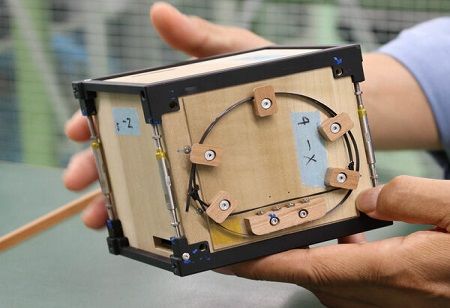Japan launched LignoSat, the first wooden satellite the in the world, breaking new ground towards further missions to the Moon and eventually Mars with a new generation of space travelers not made of steel, aluminum, or any other industrial material, but of wood. LignoSat, born from joint research by Kyoto University and Sumitomo Forestry Co., has traveled aboard SpaceX to the International Space Station for orbit around the Earth at 400 km.
LignoSat is about the size of a palm, and is going to test the possibility of using timber as a source of building material for future space habitats. Its launch marks a new innovation using sustainable materials in the quest for long-term space exploration.
"With timber, a material we can produce by ourselves, we will be able to build houses, live and work in space forever," said astronaut Takao Doi, who studies human space activities at Kyoto University.
Doi's team, with their ambitious 50-year strategy for establishing timber structures on the moon and Mars, developed this NASA-certified wooden satellite to validate wood as a space-suitable material.
"Early 1900s airplanes were made of wood. A wooden satellite should be feasible, too", said Kyoto University forest science professor Koji Murata.
Murata explained that wood exhibits enhanced durability in space due to the absence of water and oxygen that typically cause deterioration on Earth.
The researchers highlight that wooden satellites offer reduced environmental impact upon decommissioning.
Doi also said that when satellites re-enter the atmosphere to prevent space debris, traditional metal ones release aluminium oxide particles, whilst wooden satellites would decompose with minimal pollution.
"Metal satellites might be banned in the future. If we can prove our first wooden satellite works, we want to pitch it to Elon Musk's SpaceX", said Doi.
Following a 10-month International Space Station experiment, researchers identified honoki, a Japanese magnolia traditionally used for sword sheaths, as optimal for spacecraft construction.
The LignoSat satellite is made from traditional Japanese honoki wood without mechanical fasteners or adhesives. This will orbit Earth for six months, at which point its onboard electronics will keep track of the performance of the wood in the tough conditions of space, in which temperatures range from as low as -100°C to 100°C in a cycle that repeats every 45 minutes, passing from sunlight into darkness.
According to Kenji Kariya, who works in Tsukuba Research Institute in Sumitomo Forestry, this satellite would study the functioning of wood as an anti-radiation shield meant for protection from harmful space radiations to semiconductors. It might work some magic for development on data centers on earth, too.Kariya said that even though wood may seem like an old material, it can be the one to make a difference in the development of space exploration technology as humanity prepares for missions to the Moon and Mars. "Wood may seem old-fashioned, but it is at the forefront of innovation as we venture into space", he said.

